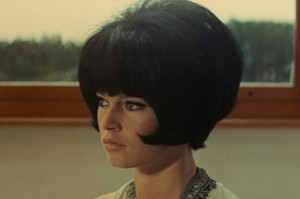Introducing: The ‘English Eerie’ Of Holloway
Featured in the Guardian and working alongside one of Britain’s finest authors, The Double Negative writer and freelance filmmaker Adam Scovell channels a very English kind of terror in his new short film, Holloway…
Did you read the Guardian article, published a couple of weeks ago, entitled The Eeriness of The English Countryside, by academic and bestselling travel writer Robert Macfarlane? In it, he name-checks masters of that particular kind of horror, the English Eerie: that is, the unease and uncanny forces felt when wandering our ancient fields and coastlines.
People like M.R. James are discussed (whose ghost stories, Macfarlane confesses, have “caused me to wake myself with my own screaming”), in addition to more contemporary eerie offerings from PJ Harvey, in albums White Chalk (2007) and Let England Shake (2011), and Ben Wheatley’s “brilliant” A Field in England. And then someone more familiar crops up.
“Over the last year”, Macfarlane writes, “I have been working with a young writer and filmmaker, Adam Scovell, to adapt a co-written book called Holloway into a nine-minute Super-8 short…” — Hang on, we cry! That’s Adam! – ”… inspired in part by Derek Jarman’s early silent film Journey to Avebury (1971).”
It did indeed turn out to be one of our most regular film critics — Scovell has written about everyone from Jen-Luc Godard to Ken Russell for us since 2012, as well as pursuing a PhD and freelance filmmaking.
Recognising Scovell’s talents after stumbling upon his popular blog, Celluloid Wicker Man, Robert Macfarlane emailed Scovell out of the blue to discuss his work and, in particular, a common interest in the English Eerie. As their conversation developed, a short adaptation of Macfarlane’s 2013 bestseller, Holloway (featured on both the Observer and Sunday Telegraph’s Books of The Year) was agreed upon and things moved swiftly from there on in, including gaining permission to use the work of English artist Stanley Donwood, aka Dan Rickwood: responsible for all of Radiohead’s album and poster art since 1994.
Did Scovell feel like he was dreaming? ”I was exploring in Switzerland and getting away from a lot of stress when he first emailed. It felt more of a surreal life-line than dreaming. I’d had a lot of knock-backs from local musicians in regards to visual collaborations, a lot of writing knock-backs and some tough criticism for my PhD applications at the time.
“So, to have this huge, successful figure come in and tell you the complete opposite to what everyone else seemed to be saying about what I was doing at the time was overwhelming.”
Filming in the overgrown ‘Holloways’ — naturally occurring tunnels of plant-life growing along sunken lanes — of Dorset’s Jurassic coast (read Scovell’s accounts of the difficult filming process here), and narrated and written by Macfarlane, the short is “about time-loops and unexplained occurrences … among its histories is the hanging at Dorchester in 1594 of four Catholic recusants.”

Filming in the dead of winter, Scovell encountered that particle type of dread, which Macfarlane describes as a “swarming in the stomach’s pit, the tell-tale prickle of the skin”.
“As a place built largely on summer season tourism,” Scovells recounts, “the Jurassic coast in particular is desolate in the brisk January days; upon my trip out to film with my trusty super 8 camera, I came across not a single soul treading upon the pathways. Whilst Holloway is not to be a film about ghosts or the more horrific elements to be found within our landscape, it could easily have descended into such areas.”
Filming alone, without a crew and seeing hardly any passers by for three days, was a much harder prospect than originally expected. He even got stuck for hours in a muddy Holloway with no way out other than through thicket, equipment and all.
Looking through the stills taken at the film location recently (and showing us some angry bramble scars) Scovell pointed out a dark shape at the end of the Holloways that he swore wasn’t there whilst filming. Or he didn’t think so, anyway (he laughs). It’s a weird echo of Scovell’s entertaining (and autobiographical?) film The Coastal Path, which follows a young filmmaker who accidentally captures a ghost on Super 8. This English Eerie, we found out, is insidious. We’re still feeling that “tell-tale prickle of the skin”.
What reaction, we wonder, does Scovell expect from the release of the full film, due at some point this year? ”I just hope people who liked the book and Robert’s writing in general will find something of interest in the film, even though they are very different forms. I do know that if people come to it expecting some sort of Countryfile episode on Dorset Holloways, they’re going to be extremely bewildered.
“Nature writing is in a real boom period at the moment but the modern film equivalents seem few and far between. Hopefully that will change in coming years as more fragments like this are made, especially as I’m determined to continue making them within narrative film forms as well as in more experimental styles, like Holloway.”
What is so fascinating, so gripping about the notion of the English Eerie is that it turns everyday, surrounding spaces into ones of creeping fear and danger. Nowhere is safe, no matter how alluring. It is seeing, as Macfarlane puts it, the “English countryside not only as a place of beauty, calm and succour, but also as a green and deeply unpleasant land.” And in the form of Holloway, we can’t wait to see the results.
Laura Robertson (TDN Editor)
See more of Adam Scovell’s films on YouTube
Read Scovell’s TDN articles here
Scovell’s film season at A Small Cinema Liverpool includes avant-garde folk horror Requiem For A Village (1975), Thursday 7 May 2015 — see full programme here





